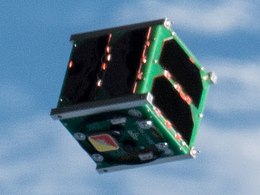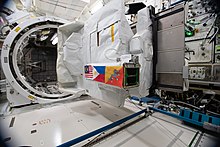cosmos.wikisort.org - Spacecraft
BHUTAN-1 was the first Bhutanese nanosatellite to be launched into space. The satellite was built during Kyushu Institute of Technology's Birds-2 program. The Birds program helps countries fly their first satellite. BHUTAN-1 was launched into orbit aboard the SpaceX CRS-15 mission on 29 June 2018. It was deployed from the Kibō module of the International Space Station (ISS) on 10 August 2018. The satellite had cameras to image the Earth.
 BHUTAN-1 above Earth | |
| Names | BIRD-BT |
|---|---|
| Mission type | Technology demonstration |
| Operator | Kyushu Institute of Technology |
| COSPAR ID | 1998-067PF |
| SATCAT no. | 43591 |
| Website | birds2 |
| Mission duration | 6-9 months (planned) |
| Spacecraft properties | |
| Spacecraft type | 1U CubeSat |
| Manufacturer | Kyushu Institute of Technology |
| Launch mass | 1.11 kg |
| Dimensions | 10 × 10 × 11.35 cm |
| Start of mission | |
| Launch date | 29 June 2018, 09:42 UTC |
| Rocket | Falcon 9 Full Thrust |
| Launch site | Cape Canaveral, SLC-40 |
| Contractor | SpaceX |
| Deployed from | International Space Station |
| Deployment date | 10 August 2018 |
| End of mission | |
| Disposal | Decay from orbit |
| Decay date | 18 November 2020[1] |
| Orbital parameters | |
| Reference system | Geocentric orbit[2] |
| Regime | Low Earth orbit |
| Periapsis altitude | 355 km |
| Apoapsis altitude | 362 km |
| Inclination | 51.64° |
Joint Global Multi-Nations Birds Satellite | |
Background
The Kyushu Institute of Technology (KIT) in Japan supports non-spacefaring countries to build their first satellite through a program called the Joint Global Multi-Nations Birds Satellite project (Birds). Five countries participated in the first Birds program (Birds-1).[3][4]
In 2016, Bhutanese Prime Minister Tshering Tobgay mentioned plans to set up a space agency with Bhutan's Information and Communications Ministry. According to Tobgay, plans to launch the first Bhutanese satellite to space came from Bhutanese King Jigme Khesar Namgyel Wangchuck.[5]
Three satellites were developed during the Birds-2 program: BHUTAN-1 (Bhutan), UiTMSAT-1 (Malaysia) and Maya-1 (Philippines). BHUTAN-1 was designed by Bhutanese graduate students who were pursuing their master's degree at Kyutech (Kyushu Institute of Technology).[6] The satellite was developed under the Kyushu Institute of Technology-led second Joint Global Multi-nations Birds Satellite (Birds-2).[7]
Development
The Birds-2 project commenced in November 2016.[5] BHUTAN-1 was classified as a 1U CubeSat and measures 10 × 10 × 11.35 cm and weighs 1.11 kilograms (2.4 lb).[6][8] The satellite was developed and designed by a team of four Bhutanese engineers. The satellite was part of their master's degree in space engineering at Kyushu Institute of Technology.[9]
The designing and testing of BHUTAN-1 began by March 2017. The functions of each sub-system of the satellite was verified before the first engineering model of BHUTAN-1 was built in June of the same year. By October 2017, the second engineering model was completed and the development of the flight module commenced.[5]
Mission
Launch


BHUTAN-1 was launched to space on 29 June 2018, via the Falcon 9 Full Thrust rocket at Cape Canaveral in Florida, as part of the SpaceX CRS-15 Commercial Resupply Service mission.[6] Maya-1 and UiTMSAT-1 which were also developed under the Birds-2 project were also among the payload of the rocket.[10] BHUTAN-1 was deployed from Kibō module of the International Space Station (ISS) in August 2018, becoming the first Bhutanese satellite.[11]
Operations
The satellite operated at an altitude of around 400 km (decaying to lower orbit as time passed) and passed over Bhutan for three to four minutes four to five times per day. Its designed lifespan was six to nine months, though theoretically it could last up to two years. BHUTAN-1's two cameras captured satellite imagery of Bhutan to help assess the country's glaciers, lakes, and forest cover. It also provided basic communication services and was used to study radiation effects on satellites.[6] While BHUTAN-1 was built solely by the Bhutanese, the satellite was jointly controlled and operated by the Bhutan, Malaysia, and Philippines.[7]
BHUTAN-1 was tracked from the ground station operated by the Information and Communications Ministry of Bhutan.[6]
References
- "BIRD-BT (BHUTAN-1)". N2YO.com. 18 November 2020. Retrieved 26 May 2022.
- "BHUTAN-1 – Satellite Information". Heavens Above. Retrieved 22 February 2020.
- "Bird B, BTN, G, J, M, MYS, N, PHL (BRAC Onnesha, GhanaSat-1, Toki, Mazaalai, Nigeria EduSat-1)". Gunter's Space Page. Archived from the original on 30 June 2017. Retrieved 24 July 2017.
- Francisco, Mikael Angelo (1 July 2018). "Space To Excel: Why The First Pinoy-Made Cube Satellite Matters". FlipScience. Retrieved 4 July 2018.
- "BHUTAN-1 expected to be in space by May 2018". Kuensel. 1 February 2018. Retrieved 4 July 2018.
- Palden, Tshering (30 June 2018). "BHUTAN-1 leaves for space". kuenselonline.com. Retrieved 4 July 2018.
- "Maya-1: Cube satellite latest Pinoy venture into space". Philippine Daily Inquirer. 1 July 2018. Retrieved 4 July 2018.
- "Joint Global Multi-Nations Birds Satellite project" (PDF) (in Japanese). Kyushu Institute of Technology. 26 February 2018. Retrieved 4 July 2018.
- Seldon, Perma (30 June 2018). "Bhutan launches its first satellite into space". The Bhutanese. Retrieved 4 July 2018.
- Panela, Shaira (29 June 2018). "Philippines launches first CubeSat into space". Rappler. Retrieved 4 July 2018.
- "Three CubeSats successfully deployed from Kibō as part of Birds Project!". JAXA. 17 August 2018. Retrieved 17 February 2020.
На других языках
[de] Bhutan-1
Bhutan-1 ist der erste bhutanische Satellit. Es handelt sich um einen Cubesat, der im Rahmen des Birds-2-Programms an der Technischen Universität Kyūshū in Japan entwickelt wurde. Das Projekt hilft kleineren Nationen dabei, erste Erfahrungen im Bereich der Weltraumforschung zu sammeln. Am 29. Juni 2018 startete der Satellit gemeinsam mit zwei Satelliten gleichen Formats, entwickelt durch Ingenieure aus Malaysia und den Philippinen, auf einer Falcon-9-Rakete in Richtung Internationale Raumstation.[1] Von dort aus wurde er am 10. August desselben Jahres in eine eigene niedrige Erdumlaufbahn entlassen.- [en] BHUTAN-1
[ru] BHUTAN-1
BHUTAN-1 (так же BIRD BTN) — первый искусственный спутник Земли, произведённый в Бутане. Аппарат был запущен 28 июня 2018 года с мыса Канаверал с помощью ракеты-носителя Falcon 9 рамках миссии SpaceX CRS-15 и служил для наблюдения Земли и проведения технических экспериментов.Другой контент может иметь иную лицензию. Перед использованием материалов сайта WikiSort.org внимательно изучите правила лицензирования конкретных элементов наполнения сайта.
WikiSort.org - проект по пересортировке и дополнению контента Википедии